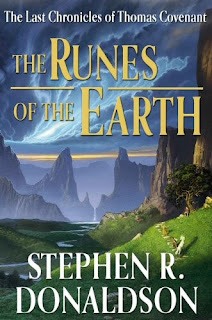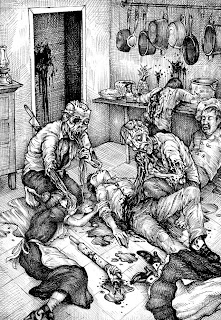 I took a break from painting my house last week and spent a day immersed in the Land, which I last read about back in the 1980's. A full 20 years have passed between the publishing of White Gold Wielder in 1983 and The Runes of the Earth, published in 2004. The Land was a reality visited by Thomas Covenant, a man with a rare form of leprosy in a series of 6 novels, always during a time when he was injured and unconscious in his real life on earth as we know it. Those novels also dealt with his struggle to wonder if what he was experiencing was real, and he was referred to as the Unbeliever. He was the quintessential reluctant hero. In the Land, he found himself in complete health and regarded as a savior, sought out for his possession of a white gold ring, capable of being used to wield wild magic, unlike his waking life where he was spurned and impotent.
I took a break from painting my house last week and spent a day immersed in the Land, which I last read about back in the 1980's. A full 20 years have passed between the publishing of White Gold Wielder in 1983 and The Runes of the Earth, published in 2004. The Land was a reality visited by Thomas Covenant, a man with a rare form of leprosy in a series of 6 novels, always during a time when he was injured and unconscious in his real life on earth as we know it. Those novels also dealt with his struggle to wonder if what he was experiencing was real, and he was referred to as the Unbeliever. He was the quintessential reluctant hero. In the Land, he found himself in complete health and regarded as a savior, sought out for his possession of a white gold ring, capable of being used to wield wild magic, unlike his waking life where he was spurned and impotent. I really enjoyed the books, but over 20 years have passed since I read them, so I took time out to read the synopsis provided at the beginning of the book. I can't say that it totally brought me up to speed. I've forgotten a lot, but it did enough to get me going.
Thomas Covenant, the hero of the first two trilogies, died in the final novel, but Linden Avery, a medical doctor who was pulled with him into the land in the second trilogy is alive back in the real world. Ten years have passed and she is still trying to find a way to reach Covenant's very insane wife, Joan Covenant. Covenant's son is now 21 and wants custody of his mother, Joan, even though he clearly lacks the ability to care for her needs. Linden is afraid of him and what he might intend and attempts to warn the local sheriff and security staff. Linden also has a special needs son, Jeremiah, she adopted after he was abused by religious nut cases who forced him at the tender age of 5 to stick his hand in a bonfire in the earlier series.
After a series of violent events initiated by Covenant's son, Linden finds herself back in the Land. She also realizes from the bullet hole in her shirt, that in the real world, she is dead, and that she cannot return to that life. Her son is missing, and apparently in the possession of The Despiser, the evil force in the Land that wants to force her to destroy the Arch of Time and release him from his prison. Approximately 3,000 years have passed in the Land, during the 10 years she has been in her own reality.
In this first novel Linden has to figure out how to use the power of the ring she inherited from Thomas to find the Staff of Law, which has been lost. She hopes it will help her find her missing son, and restore the Land to health.
There was an awful lot of exposition in the beginning to prepare new readers for the Land, and I found myself impatient for the story to get there, but it got there and in dramatic and memorable style. Once there, the story moves quickly and furiously as Linden finds herself in one desperate situation after another, fortunately finding some friends and allies along the way. She also finds herself having to deal with both the help and harm of Esmer, whose dual nature forces him to balance every deed he does to help her with one equally dastardly and potentially deadly to her and to the Land she love.
These books are not simple. This is adult fantasy, not something your kids will enjoy. This isn't the typical, go on a quest with friends, find a magic object, beat the bad guys and save the world fantasy. The issues are complicated and include the theme of unintended consequences. The reason Joan Covenant is able to wreak such havoc in the Land is because in the real world, Dr. Linden Avery, gave her back her white gold wedding ring, thinking it would soothe and calm her, not realizing that it could affect the Land when used in the real world. Each time Joan beats her head in her insanity she creates rifts in time and space in the Land called Caesures. So, even though she meant well, Linden now bears some responsibility for what the Land is now suffering. She has the ability to wield great power using her ring, but using wild magic could also unmake the world and do irreparable damage to the Arch of Time. Figuring out what action she should take that will not play into the hands of the Despiser, finding her way in a land much changed and where everyone she knew before is gone, and persuading many reluctant players to help her is part of the problem she needs to solve.
I enjoyed this first book of the series and will soon be reading the second of the series: Fatal Revenant (2007). Books 3, Against All Things Ending (2010) and Book 4, The Last Dark (2013).
The titles of the first two trilogies are listed below, in case you missed them and want to read them first.
The Chronicles of Thomas Covenant, the Unbeliever:
Lord Foul's Bane (1977)
The Illearth War (1978)
The Power that Preserves (1979)
The Second Chronicles of Thomas Covenent
The Wounded Land (1980)
The One Tree (1982)
White Gold Wielder (1983)
Visit the author's website HERE.











